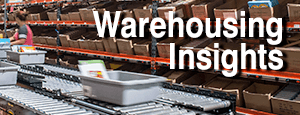Mezzanine, Platform & Pick Module Fall Prevention
Methods to help make elevated work areas safer
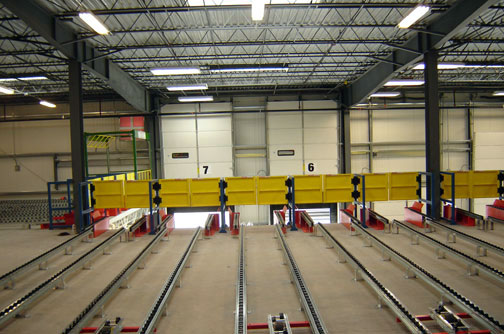
Above: the edge of this pick module, which leads to a fall of over 20 feet, is guarded by a series of pallet flow swing gates.
When companies install storage platforms, the hustle and bustle of a busy working day can soften safety processes–a kind of soft that might lead to a hard and very expensive landing. Here are some ways you can reduce issue with work platform falls.
Just how protected are your workers when on a mezzanine or pick module?
Most mezzanines have railing – hand rail, guard rail, mesh panels, etc. – but is your mezzanine truly safe? Two primary questions emerge:
- Can the railing withstand significant lateral forces before failing – say, 200 pounds of sideways pressure?
- Is it tall enough to keep someone from tumbling over the top rail?
Those are the two most common ways failing fails to protect workers on a platform or second level. People fall against the rail and it either can’t withstand the lateral pressure, or the railing is too short and they go over the top rail.
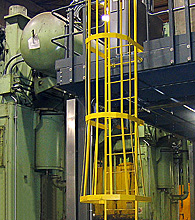
Mezzanine access points are critical
Simple gates are inadequate protection. It’s too easy to get involved with the loading and unloading and step off the mezzanine edge. Stairs should always have handrails. Same with ladders – they should have safety cages if the top rung of the ladder is more than 6′ high.
What are the right safety rails?
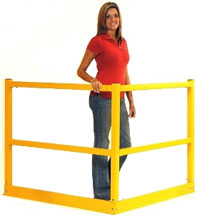
For general protection at the mezzanine edge, railing should be at least 42″ high with a mid-rail and toeboard to prevent materials from being kicked over the edge and to obstruct the opening between the top rail and the mezzanine floor level. You don’t want anyone falling through the opening below the top rail. The rail should be rated to withstand lateral force of 200 pounds point load with a 50 pound-force per linear foot load.
Read more: OSHA Handrail Guidelines
Control open ledges
For loading and unloading bays, access gates should protect edge access from the mezzanine level while materials are being raised to or lowered from the mezzanine. Once the load is in place or has been removed, the gate should be such that it closes off the mezzanine edge as access is gained to the load. In other words, the edge is not open to someone at mezzanine level at any time. There are a wide variety of gates that fulfill those requirements – but be sure you understand how they operate before you buy. Some gates do a better job than others of protecting that open edge.
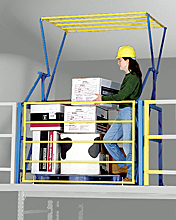
Stairs and ladders should have a gate at the top-most access point to prevent accidental falls into the stair or ladder opening – whether the opening is at the mezzanine edge or at some inner point. If at an inner point, all sides of the opening must have protective railing.
Pick module safety
Pick modules can be two, three, even four levels high — much taller, and potentially deadlier than a mezzanine. Safety gates, rails or picker protection arms are recommended for open spaces in pick modules.
Anyone can see there’s a drop-off, right?
Wrong. Even your most conscientious workers can lose their depth perception when focusing on an activity near the edge of a mezzanine.
People can easily step off the edge, not realizing they were close. They move out of someone’s way and forget there’s only air behind them, or shift to pick a carton and fall. Relying on people’s spatial awareness will fail over time.
According to the 2009 data from the Bureau of Labor Statistics, 605 workers were killed and an estimated 212,760 workers were seriously injured by falls to the same or lower level. Not all of these falls were mezzanine related, but elevated work platforms are among the hazards.
There are newer technologies, like gates that flash alarms when open, to help people understand their position when near an exposed ledge.
Safety railing, gates and other measures won’t protect someone who is determined to circumvent them (or is simply too careless), but will help protect workers who are busy and distracted.
Resources:
Tags: Safety & Ergonomics, guard rail, handrail, mezzanine gate, pedestrian safety, pedestrian gate, Space Optimization
Scott Stone is Cisco-Eagle's Vice President of Marketing with 35 years of experience in material handling, warehousing and industrial operations. His work is published in multiple industry journals an websites on a variety of warehousing topics. He writes about automation, warehousing, safety, manufacturing and other areas of concern for industrial operations and those who operate them.



